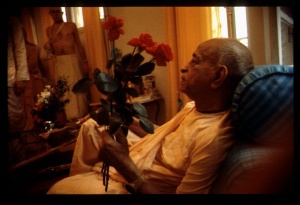SB 7.5.52

A.C. Bhaktivedanta Swami Prabhupada
TEXT 52
dharmam arthaṁ ca kāmaṁ ca
nitarāṁ cānupūrvaśaḥ
prahrādāyocatū rājan
praśritāvanatāya ca
SYNONYMS
dharmam—mundane occupational duty; artham—economic development; ca—and; kāmam—sense gratification; ca—and; nitarām—always; ca—and; anupūrvaśaḥ—according to order, or from the beginning to the end; prahrādāya—unto Prahlāda Mahārāja; ūcatuḥ—they spoke; rājan—O King; praśrita—who was humble; avanatāya—and submissive; ca—also.
TRANSLATION
Thereafter, Ṣaṇḍa and Amarka systematically and unceasingly taught Prahlāda Mahārāja, who was very submissive and humble, about mundane religion, economic development and sense gratification.
PURPORT
There are four processes for human society—dharma, artha, kāma and mokṣa—and they culminate in liberation. Human society must follow a process of religion to advance, and on the basis of religion one should try to develop his economic condition so that he can fulfill his needs for sense gratification according to the religious rules and regulations. Then liberation from material bondage will be easier to attain. That is the Vedic process. When one is above the stages of dharma, artha, kāma and mokṣa, one becomes a devotee. He is then on the platform from which he is guaranteed not to fall again to material existence (yad gatvā na nivartante (BG 15.6)). As advised in Bhagavad-gītā if one transcends these four processes and is actually liberated, one engages in devotional service. Then he is guaranteed not to fall to material existence again.